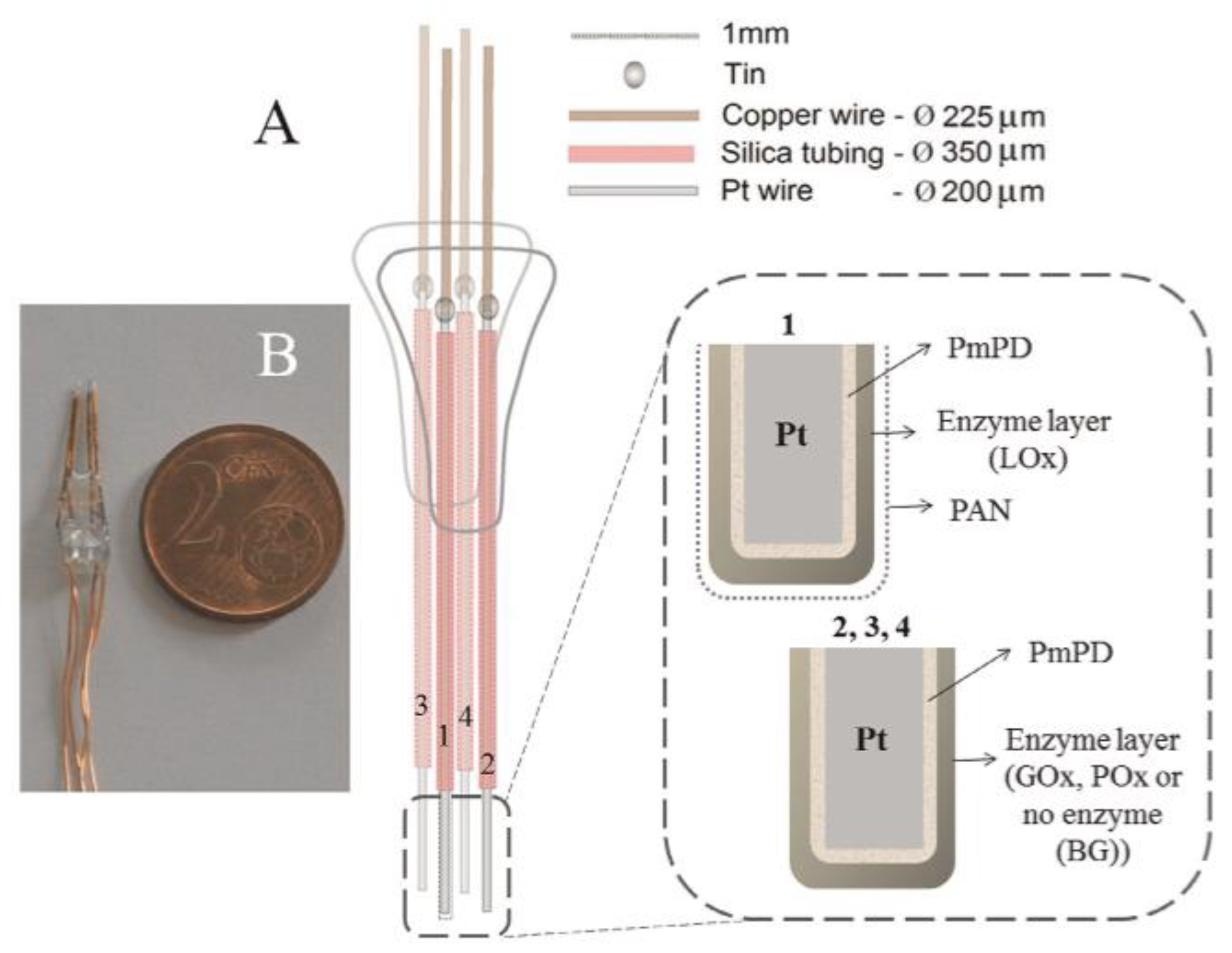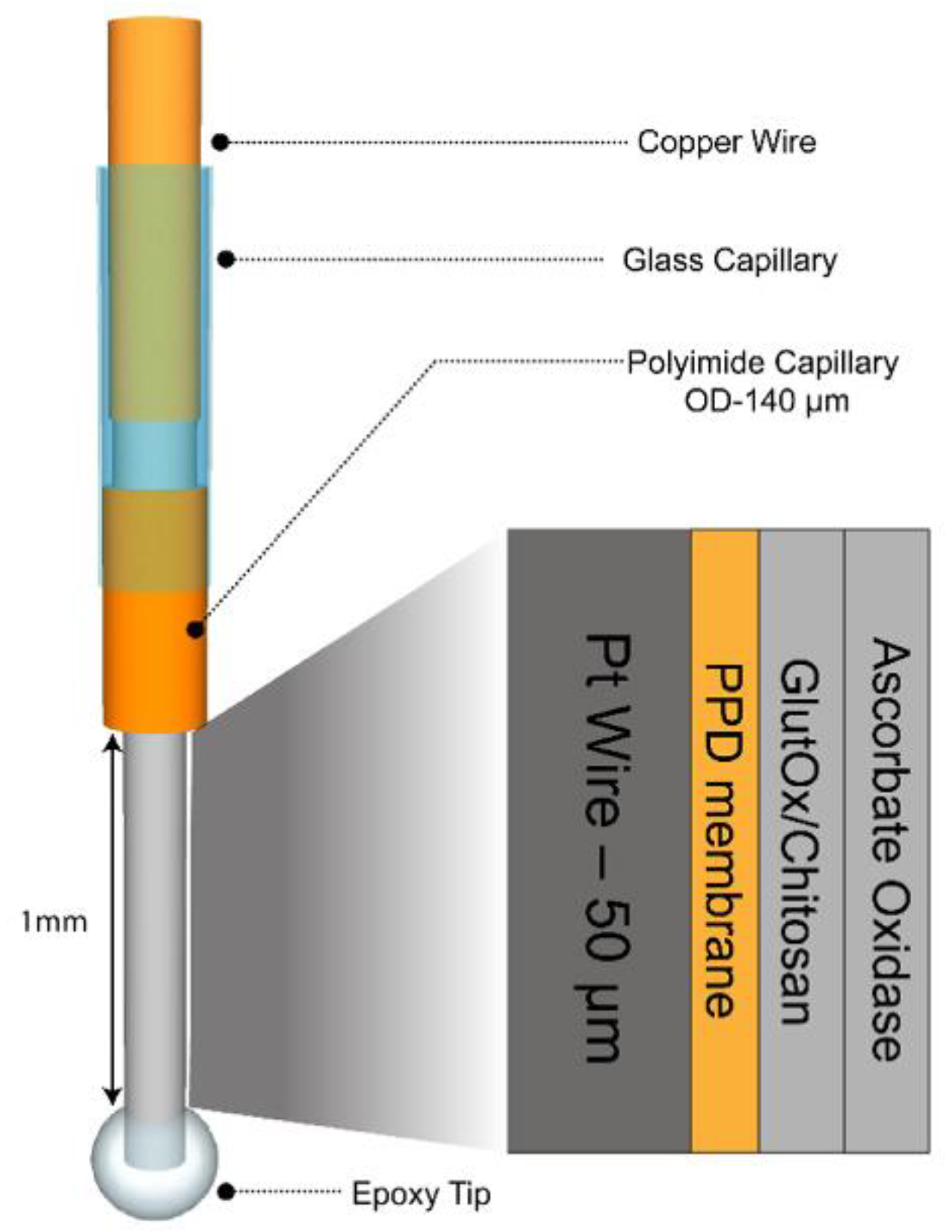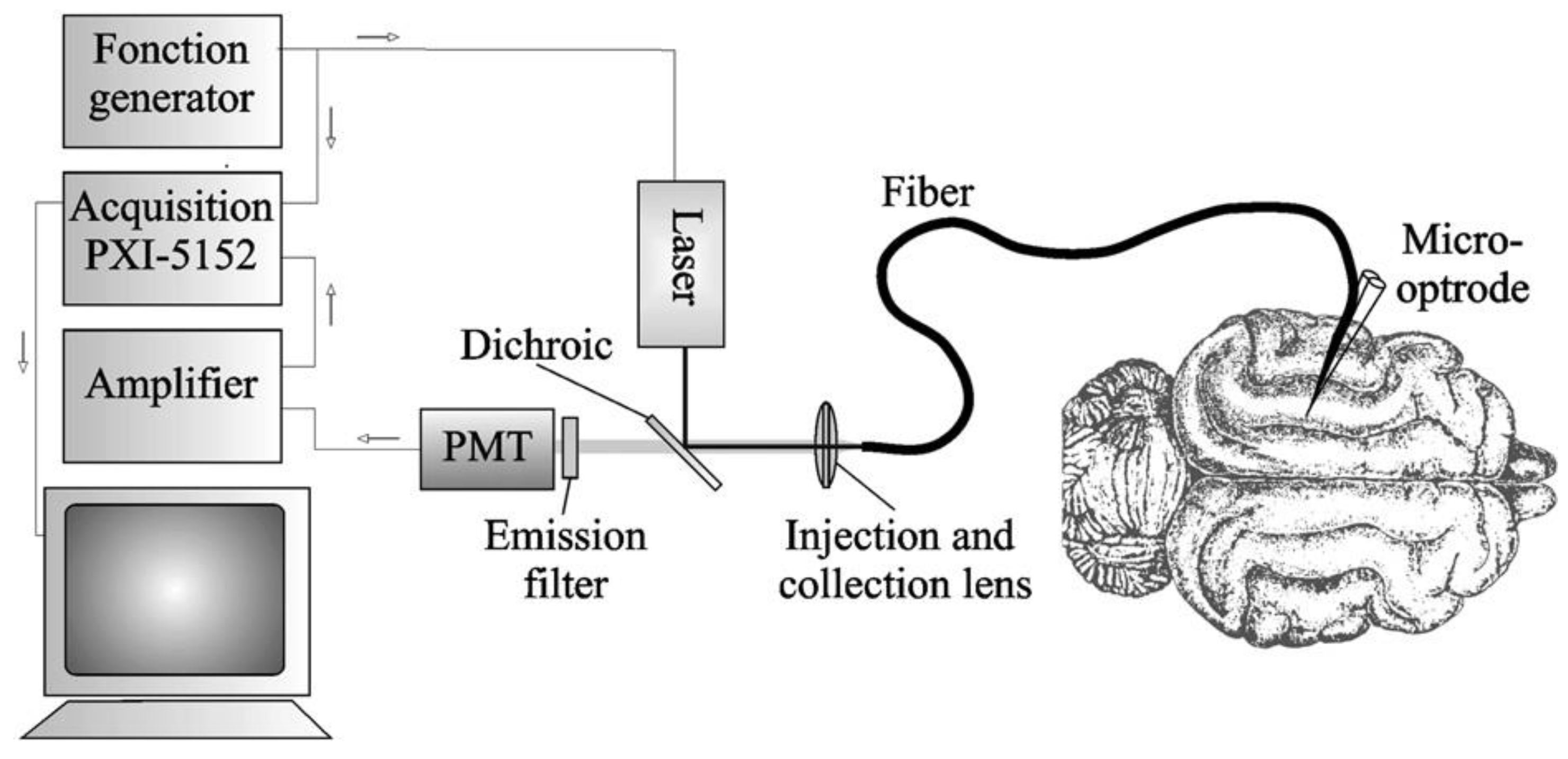Biosensor Technology in Diagnostics and Mechanistic Studies of Epilepsy †
Abstract
:1. Epilepsy
2. Biomarkers for Epilepsy
2.1. Molecular Species
2.2. The Critical Role of Potassium Cation
3. Relevant Biosensor Development
3.1. Glutamate
3.2. GABA
3.3. miRNAs
3.4. Potassium Cation
4. Final Comments
Author Contributions
Acknowledgments
Conflicts of Interest
References
- Chang, B.S.; Lowenstein, D.H. Epilepsy. N. Engl. J. Med. 2003, 349, 1257–1266. [Google Scholar] [CrossRef] [PubMed]
- Fisher, R.S.; Boas, W.V.E.; Blume, W.; Elger, C.; Genton, P.; Lee, P.; Engel, J., Jr. Epileptic seizures and epilepsy: Definitions proposed by the International League Against Epilepsy (ILAE) and the International Bureau for Epilepsy (IBE). Epilepsia 2005, 46, 470–472. [Google Scholar] [CrossRef] [PubMed]
- Alarcón, G.; Valentin, A. (Eds.) Introduction to Epilepsy; Cambridge University Press: Cambridge, UK, 2012. [Google Scholar]
- Reuber, M.; Elger, C.E. Psychogenic nonepileptic seizures: Review and update. Epilepsy Behav. 2003, 4, 205–216. [Google Scholar] [CrossRef]
- Dumanis, S.B.; French, J.A.; Bernard, C.; Worrell, G.A.; Fureman, B.E. Seizure forecasting from idea to reality. Outcomes of my seizure gauge epilepsy innovation institute workshop. Outcomes of my seizure gauge epilepsy innovation institute workshop. eNeuro 2017, 4. [Google Scholar] [CrossRef]
- Pitkänen, A.; Ndode-Ekane, X.E.; Lapinlampi, N.; Puhakka, N. Epilepsy biomarkers—Toward etiology and pathology specificity. Neurobiol. Dis. 2019, 123, 42–58. [Google Scholar] [CrossRef]
- Angus-Leppan, H. Diagnosing epilepsy in neurology clinics: A prospective study. Seizure 2008, 17, 431–436. [Google Scholar] [CrossRef]
- Engel, J., Jr.; Pitkänen, A.; Loeb, J.A.; Dudek, F.E.; Bertram, E.H., III; Cole, A.J.; Moshé, S.L.; Wiebe, S.; Fureman, B.E.; Jensen, F.E.; et al. Epilepsy Biomarkers. Epilepsia 2013, 54, 61–69. [Google Scholar] [CrossRef]
- Carlen, P.L.; Krembil Research Institute, Toronto Western Hospital, Toronto, ON, Canada. Personal Communication.
- Meldrum, B.S. The role of glutamate in epilepsy and other CNS disorders. Neurology 1994, 44 (Suppl. 8), S14–S23. [Google Scholar]
- Barker-Haliski, M.; White, H.S. Glutamatergic mechanisms associated with seizures and epilepsy. Cold Spring Harb. Perspect. Med. 2015, 5, a022863. [Google Scholar] [CrossRef]
- Khazipov, R. GABAergic Synchronization in Epilepsy. Cold Spring Harb. Perspect. Med. 2016, 6, a022764. [Google Scholar] [CrossRef]
- Simonato, N.E.M.; Henshall, D.C. Discovery and validation of blood microRNAs as molecular biomarkers of epilepsy: Ways to close current knowledge gaps. Epilepsia Open 2018, 3, 427–436. [Google Scholar]
- Thompson, M. Neurophysiological monitoring of potassium. In Compendium of In Vivo Monitoring in Rea-Time Molecular Neuroscience; Wilson, G.S., Michael, A.C., Eds.; World Scientific: Singapore, 2019; Volume 3, pp. 293–323. [Google Scholar]
- Uva, L.; Saccucci, S.; Chikhladzi, L.; Tassi, L.; Gnatkovsky, V.; Milesi, G.; Morbin, M.; de Curtis, M. A novel focal seizure pattern generated in superficial layers of the olfactory cortex. J. Neurosci. 2017, 37, 3544–3554. [Google Scholar] [CrossRef] [PubMed]
- Villa, C.; Combi, R. Potassium channels and human epileptic phenotypes: An updated overview. Front. Cell Neurosci. 2016, 10, 81. [Google Scholar] [CrossRef]
- De Curtis, M.; Uva, L.; Gnatkovsky, V.; Labrizza, L. Potassium dynamics and seizures: Why is potassium ictogenic? Epilepsy Res. 2018, 143, 50–59. [Google Scholar] [CrossRef]
- Batra, B.; Kumari SPundir, C.S. Construction of glutamate biosensor based on covalent immobilization of glutamate oxidase on polypyrrole nanoparticles/polyaniline modified gold electrode. Enzym. Microbial. Technol. 2014, 57, 69–77. [Google Scholar] [CrossRef] [PubMed]
- Cordeiro, C.A.; de Vries, M.G.; Ngabi, W.; Oonen, P.E.; Cremers, T.I.F.H.; Westerink, B.H.C. In vivo continuous and simultaneous monitoring of brain energy substrates with a multiplex amperometric enzyme-based biosensor device. Biosens. Bioelectron. 2015, 67, 677–686. [Google Scholar] [CrossRef]
- Ganesana, M.; Trikantzopoulos, E.; Maniar, Y.; Lee, S.T.; Venton, B.J. Development of a novel micro biosensor for in vivo monitoring of glutamate release in the brain. Biosens. Bioelectron. 2019, 130, 103–109. [Google Scholar] [CrossRef]
- Scoggin, J.L.; Tan, C.; Nguyen, N.H.; Kansakar, U.; Madadi, M.; Siddiqui, S.; Arumugam, P.U.; DeCosta, M.A.; Murray, T.A. An enzyme-based electrochemical biosensor probe with sensitivity to detect astrocytic versus glioma uptake of glutamate in real time in vitro. Biosens. Bioelectron. 2019, 126, 751–757. [Google Scholar] [CrossRef]
- Hossain, I.; Tan, C.; Doughty, P.T.; Dutta, G.; Murray, T.A.; Siddiqui, S.; Arumugam, P.U. A novel microbiosensor microarray for continuous ex vivo monitoring of gamma-aminobutyric acid in real-time. Front. Neurosci. 2018, 12, 500. [Google Scholar] [CrossRef]
- Kilic, T.; Erdem, A.; Ozsoz, M.; Carrara, S. microRNA biosensors: Opportunities and challenges among conventional and commercially available techniques. Biosens. Bioelectron. 2018, 99, 525–546. [Google Scholar] [CrossRef]
- Wang, H.; Wang, H.; Zhang, M.; Jia, Y.; Li, Z. A label-free aptamer-based biosensor for microRNA detection by the RNA-regulated fluorescence of malachite green. RSC Adv. 2019, 9, 32906–32910. [Google Scholar] [CrossRef] [PubMed]
- Afzalinia, A.; Mirzaee, M. Ultrasensitive fluorescent miRNA biosensor based on a “sandwich” oligonucleotide hybridization and fluorescence resonance energy transfer process using an Ln(III)-MOF and Ag nanoparticles for early cancer diagnosis: Application of central composite design. ACS Appl. Mater. Interfaces 2020, 12, 16076–16087. [Google Scholar] [CrossRef] [PubMed]
- Gao, Y.; Han, Y.; Pang, J.; Wang, C.; Wang, Y.; Liu, H.; Zhang, Y.; Han, L. Ultrasensitive label-free miRNA sensing based on a flexible graphene field-effect transistor without functionalization. ACS Appl. Electron. Mater. 2020, 2, 1090–1098. [Google Scholar] [CrossRef]
- Thamm, S.; Müller, P.; Csáki, A.; Fritzsche, W.; Zuccheri, G. A miRNA biosensor based on localized surface plasmon resonance enhanced by surface-bound hybridization chain reaction. Biosens. Bioelectron. 2020, 167, 112465. [Google Scholar]
- Heinemann, U.; HDLux, H.D.; Gutnick, M.J. Extracellular free calcium and potassium during paroxysmal activity in the cerebral cortex of the cat. Exp. Brain Res. 1977, 27, 237–243. [Google Scholar] [CrossRef]
- Amzica, F.; Massimino, M.; Manfridi, A. Spatial buffering during slow and paroxysmal sleep oscillations in cortical networks of glial cells in vivo. J. Neurosci. 2002, 22, 1042–1053. [Google Scholar] [CrossRef]
- Dufour, S.; Dufour, P.; Chever, O.; Vallée, R.; Amzica, F. In vivo simultaneous intra- and extracellular potassium recordings using a micro-optrode. J. Neurosci. Methods 2011, 194, 206–217. [Google Scholar] [CrossRef]
- Machado, R.; Soltani, N.; Dufour, S.; Salam, M.T.; Carlen, P.L.; Genov, R.; Thompson, M. Antifouling impedimetric sensor for the array high-resolution extracellular potassium monitoring in the brain. Biosensors 2016, 6, 53–64. [Google Scholar] [CrossRef] [PubMed]
- Gabran, S.R.I.; Salam, M.T.; Dian, J.; El-Hayek, Y.; Perez Velazquez, J.L.; Genov, R.; Carlen, P.L.; Salama, M.M.A.; Mansour, R.R. High-density intracortical microelectrode arrays with multiple metallization layers for fine-resolution neuromonitoring and neurostimulation. IEEE Trans. Neural Syst. Rehab. Eng. 2013, 21, 869–879. [Google Scholar] [CrossRef] [PubMed]
- Blaszykowski, C.; Sheikh, S.; Thompson, M. A Survey of state-of-the-art surface chemistries to minimize fouling from human and animal biofluids. Biomater. Sci. 2015, 3, 1335–1370. [Google Scholar] [CrossRef]
- Sawan, M.; Salam, M.T.; Le Lan, J.; Kassab, A.; Gélinas, S.; Vannasing, P.; Lesage, F.; Lassonde, M.; Nguyen, D.K. Wireless recording systems: From noninvasive EEG-NIRS to invasive EEG devices. IEEE Trans. Biomed. Circuits Syst. 2013, 7, 186–195. [Google Scholar] [CrossRef] [PubMed]






Publisher’s Note: MDPI stays neutral with regard to jurisdictional claims in published maps and institutional affiliations. |
© 2020 by the authors. Licensee MDPI, Basel, Switzerland. This article is an open access article distributed under the terms and conditions of the Creative Commons Attribution (CC BY) license (https://creativecommons.org/licenses/by/4.0/).
Share and Cite
Thompson, M.; Ackroyd, A.J. Biosensor Technology in Diagnostics and Mechanistic Studies of Epilepsy. Proceedings 2020, 60, 20. https://doi.org/10.3390/IECB2020-07052
Thompson M, Ackroyd AJ. Biosensor Technology in Diagnostics and Mechanistic Studies of Epilepsy. Proceedings. 2020; 60(1):20. https://doi.org/10.3390/IECB2020-07052
Chicago/Turabian StyleThompson, Michael, and Amanda J. Ackroyd. 2020. "Biosensor Technology in Diagnostics and Mechanistic Studies of Epilepsy" Proceedings 60, no. 1: 20. https://doi.org/10.3390/IECB2020-07052




